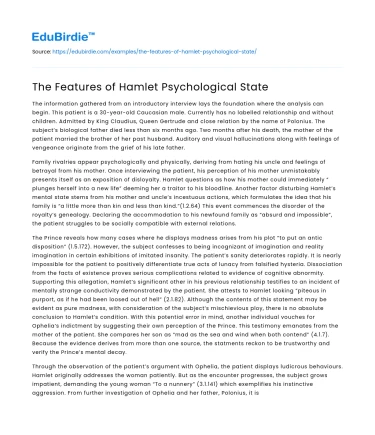The information gathered from an introductory interview lays the foundation where the analysis can begin. This patient is a 30-year-old Caucasian male. Currently has no labelled relationship and without children. Admitted by King Claudius, Queen Gertrude and close relation by the name of Polonius. The subject’s biological father died less than six months ago. Two months after his death, the mother of the patient married the brother of her past husband. Auditory and visual hallucinations along with feelings of vengeance originate from the grief of his late father.
Family rivalries appear psychologically and physically, deriving from hating his uncle and feelings of betrayal from his mother. Once interviewing the patient, his perception of his mother unmistakably presents itself as an exposition of disloyalty. Hamlet questions as how his mother could immediately “ plunges herself into a new life” deeming her a traitor to his bloodline. Another factor disturbing Hamlet’s mental state stems from his mother and uncle’s incestuous actions, which formulates the idea that his family is “a little more than kin and less than kind.”(1.2.64) This event commences the disorder of the royalty’s genealogy. Declaring the accommodation to his newfound family as “absurd and impossible”, the patient struggles to be socially compatible with external relations.
Save your time!
We can take care of your essay
- Proper editing and formatting
- Free revision, title page, and bibliography
- Flexible prices and money-back guarantee
The Prince reveals how many cases where he displays madness arises from his plot “to put an antic disposition” (1.5.172). However, the subject confesses to being incognizant of imagination and reality imagination in certain exhibitions of imitated insanity. The patient’s sanity deteriorates rapidly. It is nearly impossible for the patient to positively differentiate true acts of lunacy from falsified hysteria. Dissociation from the facts of existence proves serious complications related to evidence of cognitive abnormity. Supporting this allegation, Hamlet’s significant other in his previous relationship testifies to an incident of mentally strange conductivity demonstrated by the patient. She attests to Hamlet looking “piteous in purport, as if he had been loosed out of hell” (2.1.82). Although the contents of this statement may be evident as pure madness, with consideration of the subject’s mischievious ploy, there is no absolute conclusion to Hamlet’s condition. With this potential error in mind, another individual vouches for Ophelia’s indictment by suggesting their own perception of the Prince. This testimony emanates from the mother of the patient. She compares her son as “mad as the sea and wind when both contend” (4.1.7). Because the evidence derives from more than one source, the statments reckon to be trustworthy and verify the Prince’s mental decay.
Through the observation of the patient’s argument with Ophelia, the patient displays ludicrous behaviours. Hamlet originally addresses the woman patiently. But as the encounter progresses, the subject grows impatient, demanding the young woman “To a nunnery” (3.1.141) which exemplifies his instinctive aggression. From further investigation of Ophelia and her father, Polonius, it is evident the true motive behind Ophelia’s visitation. Due to conscription by Ophelia’s father, she acts as the mole in the operation. The patient triggers the abrupt demise of the relationship as the information revealed is taken directly. This event demonstrates the subject’s discrepancy with internal relations with his mind. While eavesdropping behind a curtain of a conversation between the Prince and his childhood friends, Hamlet mentions disparity when regarding the existence of Mankind. Categorizing humans “in apprehension how like a god” (2.2.315) and then connecting mortals to “quintessence of dust” (2.2.317) exhibits a mental battle in the subject resulting in conflicting ideologies. Immediately contradicting his words reinforces the extreme fluctuations of his state of mind.
Hamlet accounts for several symptoms of depression. The patient reports he stumbled upon the ghost of his late father who compelled Hamlet to “revenge his foul and most unnatural murder” (1.5.25). Claiming to have interacted with the phantom of elder Hamlet instantiates his auditory and visual aberrations. Prior to Hamlet’s “reunion” with his father, commotion from inside the castle of Elsinore can be overheard. From observation in a neighbouring room, the subject displays perturbation, wishing his “sullied flesh would melt, thaw, and resolve itself into a dew” (1.2.129) while addressing himself. This discourse radiates deranging characteristics as it is not the first case where the patient contradictorily conversates alone. When he asks “To be or not to be?” (3.1.58) displays another incident where the Prince questions himself paradoxically. In solitary and distress, the patient contemplates self-slaughter dictating his hysterical and consternating character. From vivid hallucinations, speculation of suicide to anxious demeanour, the manifestations of the patient correlate to a depressive disorder.






 Stuck on your essay?
Stuck on your essay?

